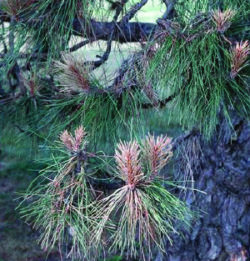Tree Diagnosis and Treatment
Make sure you are getting a proper and accurate diagnosis of tree health issues. Here is a short story about a recent visit I had with a customer. Unfortunately, I come across situations like it very frequently in Sioux Falls.
The phone rang one day with a man curious if I can help him with his pine trees. He had had a few other people look at them and was looking for a second opinion.
I made an appointment with the man and was able to show up at his home later that day. We walked into the backyard I thought I already knew what his questions were going to be based on what I saw. He then asked me a completely different question that wasn’t related to what I had already thought was his concern. He had a row of several scotch pine (Pinus sylvestris). One had already died and the other was dying. It was clear to me that the trees were being killed by the pine wilt nematode, the trees had Pine Wilt Disease (Fact Sheet). But he wasn’t asking about that, he was asking about Zimmerman Pine Moth (Fact Sheet). He had been told that his trees had Zimmerman Pine Moth (ZPM) and Diplodia Tip Blight (Fact Sheet) and that he needed to have the trees sprayed to prevent and more trees from dying. He was asking me if that was the right course of action to save the trees and a worthwhile investment. That was an easy answer, No.
His scotch pine didn’t even have Diplodia tip blight or ZPM!
Those two issues can affect scotch pine, but not commonly. And, those two issues never kill a tree outright and as quickly as pine wilt does. They can weaken a tree and cause it to decline over the course of several years. But these particular trees looked in great shape. The other bummer about this is that he had already had the trees sprayed for ZPM in late July. The proper timing to spray for ZPM is either early spring (April) or late summer, early fall (September). Even if he had ZPM, there wouldn’t have been any control, because the spraying was done at the wrong time of year.

Diplodia tip blight in an Austrian pine.
So how can you know if the issues you have is getting taken care of properly? There are a few key factors when it comes to plant diagnosis and I’ll lay them out here for you:
-
Plant Identification
– In order to diagnose problems the person must be able to know what kind of plant they are looking at. So many pest and disease issues are species specific. For example, emerald ash borer will only attack and kill trees in the ash (Fraxinus) genus. So it will not attack mountain ash (Sorbus aucuparia). If you or the person looking at your tree cannot identify the tree to its species, diagnosis will be very difficult.
-
Pest or Disease Life Cycle
– Another important factor is being able to know how the pest or disease attacks or infects the tree. For Example, you can find spruce spider mite damage year round, but the mites are only actively feeding and active in the spruce trees in the early spring or fall. You can find other mites in the summer, but those are not the ones doing the damage.
-
Timing
– This goes along with knowing the pest. In the spider mite example (like the ZPM example above) if you spray in the summer the treatment will be ineffective. And this applies for a wide variety of pest, disease, or other tree health issues. So many tree health related issues require specific timing for the application or there will be inadequate or incomplete control of the issue. The best example is Apple Scab. If the spraying is even missed by a day or more, there will not be adequate control of the fungal infections!
-
Pest or Disease Identification
– This one is a bit obvious, but being able to properly identify exactly what the issue is is very important. Some issues will be present, but not causing the damage. Other issues look like one thing, but can actually be something completely different.
-
“I don’t know”
– Being able to say when I don’t know what is going on is just as important as saying when I do know what the issue is. There are times when it isn’t clear what the problem is. If that is the case, I will gather as much information as I can and research the issue, consult with other professionals and find out what the issue is before recommending a treatment action. Treatment without proper diagnosis is malpractice.

